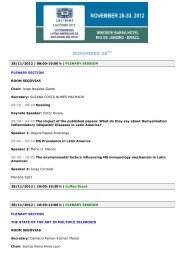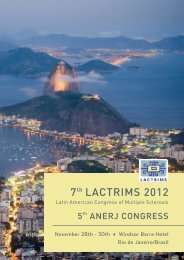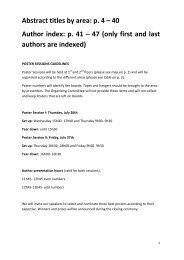Keynote Conference - Interevent
Keynote Conference - Interevent
Keynote Conference - Interevent
You also want an ePaper? Increase the reach of your titles
YUMPU automatically turns print PDFs into web optimized ePapers that Google loves.
Symp #30 Telomeres<br />
Chair Maria Isabel Cano<br />
Saccharomyces cerevisiae as a model for the study of telomere-mediated replicative senescence<br />
Maria Teresa Teixeira<br />
Emilie Fallet, Pascale Jolivet, Julien Soudet, Zhou Xu, Kamar Serhal and Maria Teresa Teixeira<br />
Institut de Biologie Physico-Chimique, FRE3354 CNRS/UPMC Biologie Moléculaire et Cellulaire des Eucaryotes - 13 rue<br />
Pierre et Marie Curie, 75005 Paris, France ; ERC-STG-2010 D-END<br />
In the absence of telomere length maintenance, telomeres shorten progressively with every replication cycle due to<br />
the DNA-end replication problem. This leads to a permanent cell cycle arrest called replicative senescence. In humans,<br />
this process is involved in the aging of certain organs and in suppression of cancer. Telomeres can be re-elongated by<br />
telomerase or more rarely by homologous recombination (HR) in cells that proliferate indefinitely such as unicellular<br />
eukaryotes, stem cells and cancer cells of multicellular eukaryotes. In telomerase-deficient yeast cells, replicative<br />
senescence is defined as an arrest in G2/M after 60-80 generations as telomeres shorten 2-4 nt/cell division. Our<br />
analysis of the DNA-end replication problem formally demonstrate that telomere shortening occurs during the<br />
synthesis of the leading strand and depends on the length of the 3’-protruding end of chromosomes. Together with<br />
the study of factors that regulate the resection and the synthesis of the 5’ strand, our data support a precise molecular<br />
model of the DNA replication of telomeres. Senescence in yeast depends on the DNA damage checkpoints, similar to<br />
other eukaryotes. A mathematical modeling of the distribution of telomere length and analysis of meiotic products<br />
suggests that the shortest telomere in a cell may have a determinant role in the onset of senescence. Accordingly, the<br />
DNA damage checkpoints recognize a very short telomere in senescent cells, triggering a replication fork regression<br />
and sister chromatid HR. We propose that these pathways counteract the telomere shortening rate allowing a few<br />
additional cell divisions before definitive arrest<br />
Telomere dysfunction in human disease<br />
Rodrigo Calado<br />
University of São Paulo, Ribeirão Preto, Brazil<br />
Telomeres and telomere repair are basic molecular features of cells possessing linear DNA chromosomes and defects<br />
in them result in various diseases. Severe deficiencies result in dyskeratosis congenita, a congenital aplastic anemia<br />
with associated mucocutaneous abnormalities. Mutations in TERT, the catalytic component, and TERC, the RNA<br />
template, can behave as risk factors for the development of bone marrow failure, pulmonary fibrosis, and hepatic<br />
cirrhosis. Both penetrance and organ specificity are variable and not well understood. Chromosome instability is a<br />
result of critical shortening of telomeres and cancer.<br />
Searching for a CST-like complex at Leishmania spp. telomeres<br />
Maria Isabel Cano<br />
Instituto de Biociências, Depto. de Genética, UNESP-Botucatu, São Paulo-Brazil, 18618-970, micano@ibb.unesp.br<br />
In most eukaryotes telomere binding proteins play crucial roles by interacting with several other regulators to ensure<br />
proper telomere maintenance and to form high order complexes. The CST complex, mainly formed by RPA-like<br />
proteins, is being considered a second telomere capping mode occurring from budding yeast to higher eukaryotes.<br />
The role of CST in chromosome-end protection couples the conventional replication machinery and telomere<br />
functions and highlights the complexity of the end- protection process. Leishmania spp. telomeres are composed by<br />
TTAGGG repeats which are maintained by telomerase. The basic Leishmania telomeric complex is formed by the<br />
proteins RPA-1 and Rbp38, which bind in vitro and in vivo, with high affinity to the G-rich telomeric strand, and by the<br />
TRF orthologue representing a shelterin component of this protozoan. Using a large scale search on the tri-tryps<br />
database we were able to confirm that the Leishmania spp. genome, like other trypanosomatids, lacks all of the<br />
conserved telomere-end-binding proteins found in other eukaryotes, such as the key components of the CST (e.g.<br />
CDC13 and CTC) and the shelterin (POT1) complexes. Thus, we speculate that the Leishmania RPA-1 homologue may<br />
play the same roles as POT1/CDC13 at parasite telomeres. In this report we used different approaches to show that<br />
RPA-1 interacts with both Rbp38 and with telomerase. And also that the putative Leishmania CST-like complex meets<br />
the TRF orthologue by physical interactions between Rbp38 and TRF. We speculate whether these protein interactions<br />
reflect the entire telomeric complex or the presence of functionally distinct subcomplexes at parasite telomeres.<br />
Supported by: FAPESP, CNPq<br />
82





